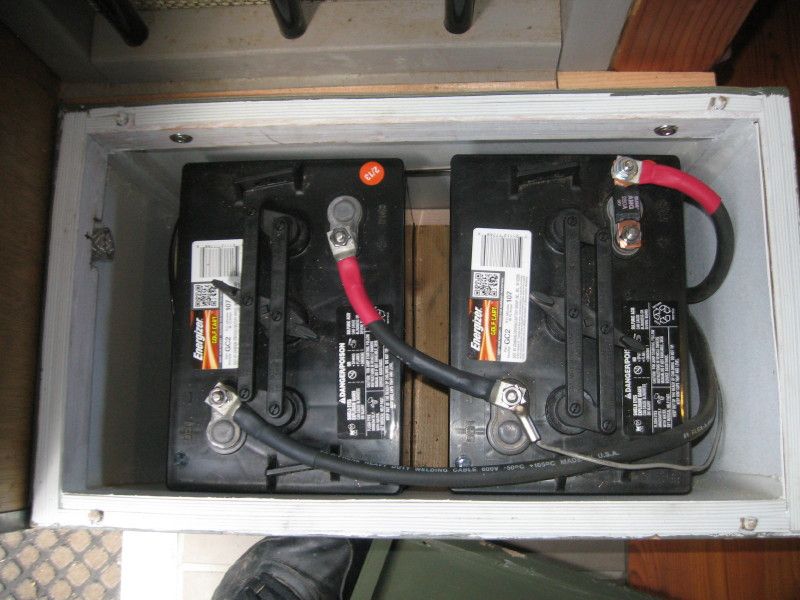Forum Discussion
- westendExplorerTwo 6V batteries connected with #1 welding cable:

I later sprayed on a coating of terminal protection onto the battery terminals. - landyacht318Explorer
Huntindog wrote:
I use the stuff sold at the auto parts store.
I did too. Once.
Here are the rusted steel ring terminals sticking to some magnets.
Autoparts cable is also SAE gauge. SAE wire sizes are 6%–12% smaller than AWG, and carry proportionally less current. - I will go with the #2 between the batteries. Likely 6ga. off the batteries to the trailer. Has 8ga. now. No inverter on my rig.
thanks, - B_O__PlentyExplorer II
DrewE wrote:
Mine were all copper. I used copper terminals as well. Just used it for thr short cables that connect the 6 volt batteries to each other. The rest are 2 gauge that I already had.B.O. Plenty wrote:
I used some #4 that I cut from a pair of jumper cables. Made my own lengths and the cost was much lower than buying them.
B.O.
If it's working well and safely for you, I don't want to suggest you change stuff.
But, in general, it's worth noting that nearly all jumper cables these days are made using copper clad aluminum wire, and so the current carrying capacity is not equal to that of the same gauge of copper wire. - HuntindogExplorer
BFL13 wrote:
Voltage drop won't be an issue for a length of less than 12 inches.
All these wire gauge questions come to the same thing:
A. ampacity so you can do the amps at all
B. voltage drop so you can operate your equipment
Lots of people seem to read the ampacity tables to get the safe size of wire, and miss the point about such things as staying above the inverter alarm voltage, converter voltage as seen at the battery, and solar controller set points
Once you have the safe ampacity solved then the lesson learned is often to go bigger than that to address the voltage drop issue.
I use the stuff sold at the auto parts store.
Everyone here (I think) understands that upsizing wire is necessary for long runs.... I once used some really thick stuff for a 25' run, I forget the gauge, but it was thicker than my thumb. But for the short, wire pairing the sixes, I used the auto parts store stuff... 4 Gauge as I recall. - BFL13Explorer IIAll these wire gauge questions come to the same thing:
A. ampacity so you can do the amps at all
B. voltage drop so you can operate your equipment
Lots of people seem to read the ampacity tables to get the safe size of wire, and miss the point about such things as staying above the inverter alarm voltage, converter voltage as seen at the battery, and solar controller set points
Once you have the safe ampacity solved then the lesson learned is often to go bigger than that to address the voltage drop issue. - DrewEExplorer II
B.O. Plenty wrote:
I used some #4 that I cut from a pair of jumper cables. Made my own lengths and the cost was much lower than buying them.
B.O.
If it's working well and safely for you, I don't want to suggest you change stuff.
But, in general, it's worth noting that nearly all jumper cables these days are made using copper clad aluminum wire, and so the current carrying capacity is not equal to that of the same gauge of copper wire. - BFL13Explorer IIDepends if you have two or four 6s :)
- wa8yxmExplorer III
B.O. Plenty wrote:
I used some #4 that I cut from a pair of jumper cables. Made my own lengths and the cost was much lower than buying them.
B.O.
Small difference is I'd use #4, which is standard Starter cable, which you can get pre-cut and assembled in assorted lengths, at any auto parts place.
This is what came in my motor home It is low cost, pre-assembled, generally much more than you need (less you have a multiple thousand watt inverter which I do, but even with that it worked fine)
But the major advantages are low-cost and pre-cut and assembled at the auto store. - MEXICOWANDERERExplorerIMHO good choice Roy Ken. Fine strands make for supple wire. Biggest gripe I have with welding cable is the insulation pulls away from terminals. The Ancor wore like the stuff genuinedealz sells is a lot better. The black DLO wire I use has insulation as tough as cross linked but is thicker and harder to cut. The penalty is suppleness. The Kynar/Teflon Space Shuttle cable in the gen shed is stiff stuff but will be around for the 22nd century. I am going to dip my lugs in the solder pot and coat them with pure Pb.
About Technical Issues
Having RV issues? Connect with others who have been in your shoes.24,208 PostsLatest Activity: Feb 24, 2025